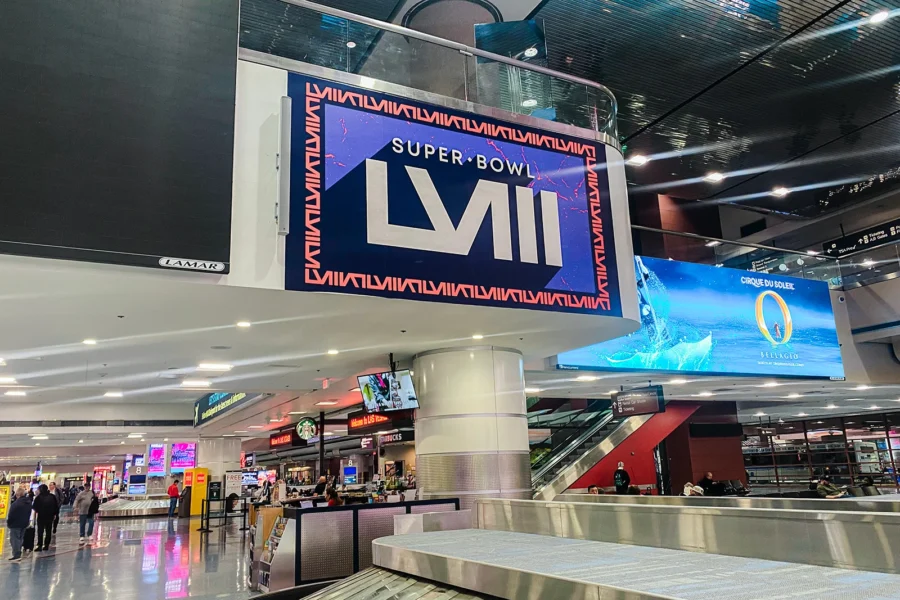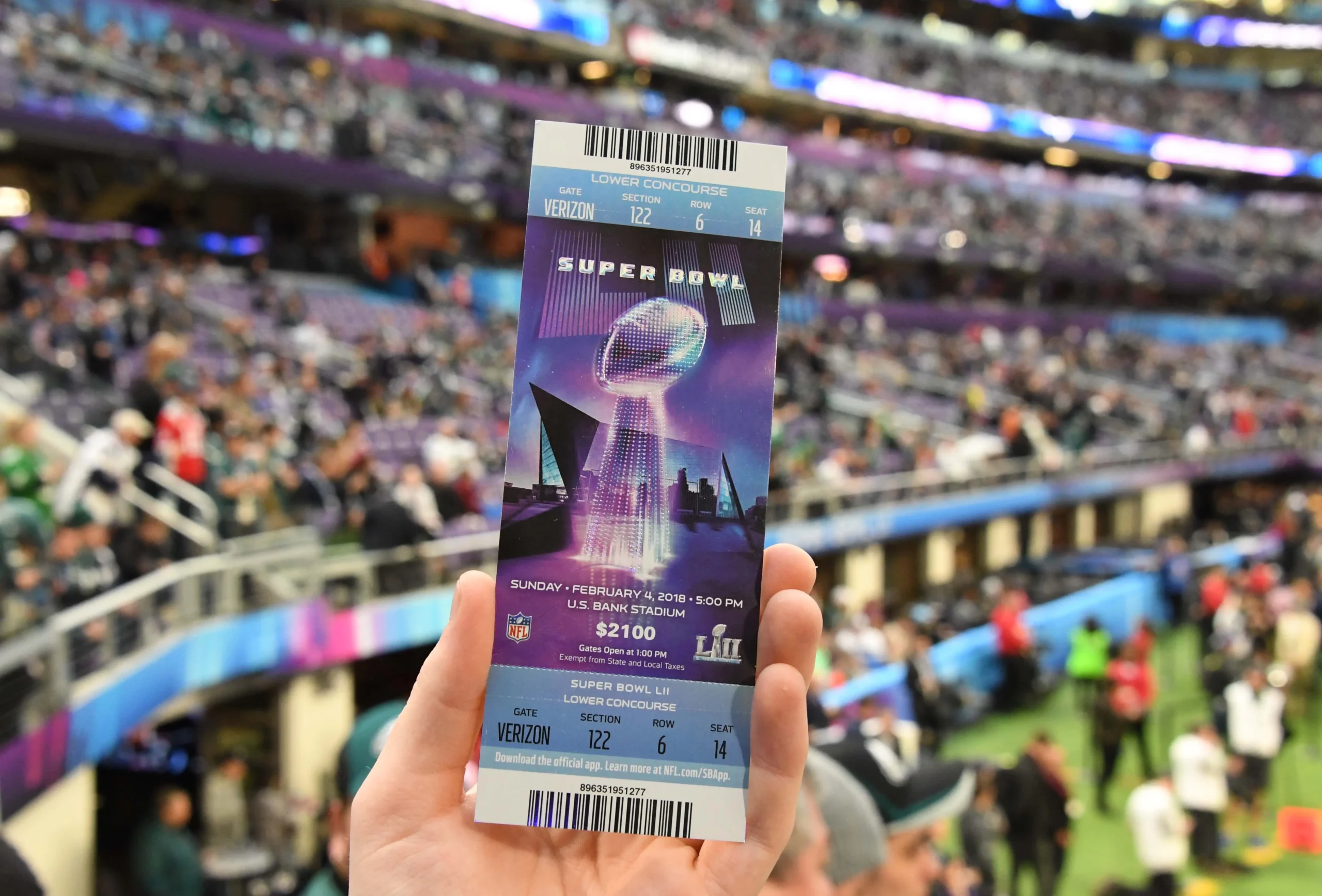Attending the Super Bowl is a bucket-list experience for many football fans, but how much does it cost? The cost of going to the Super Bowl varies depending on where you’re traveling from, your ticket choice, accommodations, and other expenses. While it’s no secret that Super Bowl tickets are expensive, the total trip can easily add up to five figures. Let’s break down the true cost of going to the Super Bowl, using Super Bowl LIX in New Orleans as our guide.

Super Bowl Ticket Prices: What You’ll Pay to Get In
The most significant expense when attending the Super Bowl is, of course, the ticket. The cost of going to the Super Bowl largely depends on when and where you buy your ticket. Super Bowl tickets have skyrocketed over the years, and resale prices fluctuate based on demand.
Here’s a look at the average Super Bowl ticket price over the last five years:
- Super Bowl LIX (2025) – New Orleans: Average resale price: $8,076, with the cheapest tickets around $3,000-$3,500 and premium seating exceeding $12,000.
- Super Bowl LVIII (2024) – Las Vegas: Average price: $9,800, with some resale tickets selling for as high as $40,000.
- Super Bowl LVII (2023) – Phoenix: Average price: $6,500, with lowest tickets at $4,800.
- Super Bowl LVI (2022) – Los Angeles: Average price: $8,869, with luxury seating well over $30,000.
- Super Bowl LV (2021) – Tampa Bay: Average price: $7,589, impacted by COVID-19 restrictions and limited capacity.
Ticket prices fluctuate, but the cost of going to the Super Bowl has consistently been between $6,000 and $10,000 per ticket on average. If you’re looking for a premium experience, expect to pay well over $15,000 to $20,000 for VIP access.
Travel Expenses: Flights to the Super Bowl City
Once you’ve secured your ticket, you need to factor in travel costs. The cost of going to the Super Bowl heavily depends on your location. Let’s assume you’re traveling from a major U.S. city to New Orleans for Super Bowl LIX.
- Flights from New York (JFK) to New Orleans (MSY): Around $400–$700 round trip
- Flights from Los Angeles (LAX) to New Orleans: Around $500–$800 round trip
- Flights from Chicago (ORD) to New Orleans: Around $350–$600 round trip
If you’re booking last-minute, expect to pay a premium of up to $1,000+ per ticket. The Super Bowl is a massive event, and airlines often increase prices leading up to the big game.

Hotel Costs: Where You’ll Stay for Super Bowl Weekend
Hotel rates skyrocket in the Super Bowl host city as demand surges. If you’re staying in downtown New Orleans, near the Caesars Superdome, here’s what you can expect to pay:
- Budget hotels & motels: $500–$1,000 per night
- Mid-range hotels (Hilton, Marriott, etc.): $1,500–$2,500 per night
- Luxury hotels & resorts: $3,000+ per night
For a three-night stay, your accommodation cost could range from $1,500 (budget) to $9,000+ (luxury stay). Some fans opt for Airbnb rentals, but even those go for $500+ per night in prime locations.
Transportation: Getting Around on Super Bowl Weekend
New Orleans has an extensive public transportation system, but on Super Bowl weekend, expect major traffic and surge pricing on rideshares like Uber and Lyft.
- Rental Car: $100–$250 per day (not including parking fees)
- Uber/Lyft: $30–$80 per ride on Super Bowl day
- Public Transit (Streetcar, Bus, etc.): $1.25 per ride (but expect delays)
- Parking Near Caesars Superdome: $100–$300 for game day
If you don’t mind walking, you can avoid some of these costs but expect long waits for rideshares after the game.
Food & Drinks: Eating in the Super Bowl Host City
New Orleans is known for its incredible food scene, so you’ll probably want to enjoy some Cajun and Creole cuisine while you’re in town. Here’s an estimate of what you’ll spend:
- Casual dining (Po’Boys, Gumbo, Jambalaya, etc.): $15–$30 per meal
- Mid-range restaurants: $40–$75 per meal
- Fine dining: $100+ per meal
- Game Day Snacks & Drinks (Inside the Stadium):
- Beer: $15–$18
- Soft Drinks: $7–$10
- Hot Dogs, Nachos, etc.: $10–$20
Over a three-day trip, expect to spend anywhere from $200 (budget-friendly) to $1,000+ (fine dining and drinks).
Super Bowl Merchandise & Extras
If you’re going to the Super Bowl, you’ll probably want to buy some memorabilia. Expect the following costs:
- Super Bowl Official Jersey: $120–$180
- Super Bowl Hat: $40–$60
- Game Program: $20–$30
- Stadium Souvenirs: $50–$200
If you plan on buying exclusive Super Bowl gear, add $200–$500 to your total budget.
The Final Price Tag: What It Costs to Attend the Super Bowl
Now, let’s add everything up for an average fan attending the Super Bowl from out of state:
| Expense | Estimated Cost (Per Person) |
|---|---|
| Super Bowl Ticket | $6,000 – $10,000 |
| Flights | $400 – $1,000 |
| Hotel (3 nights) | $1,500 – $9,000 |
| Transportation | $150 – $500 |
| Food & Drinks | $200 – $1,000 |
| Merchandise | $200 – $500 |
| Total Cost | $8,450 – $22,000+ |
For a mid-range trip, expect to spend around $10,000–$15,000 per person. For a luxury experience, your cost of going to the Super Bowl could exceed $30,000.
Is Going to the Super Bowl Worth It?
Attending the Super Bowl is an unforgettable experience, but it comes at a high price. The cost of going to the Super Bowl includes far more than just the ticket—it’s a multi-day investment that requires careful planning.
For some, watching the big game from home with friends and family is a more budget-friendly option. However, for die-hard fans, the Super Bowl is a once-in-a-lifetime event that’s worth every penny. If you’re planning to go, start saving early, book flights and hotels in advance, and be prepared for high demand.
Would you spend $10,000+ to attend the Super Bowl, or would you rather watch from home? Let us know in the comments!
